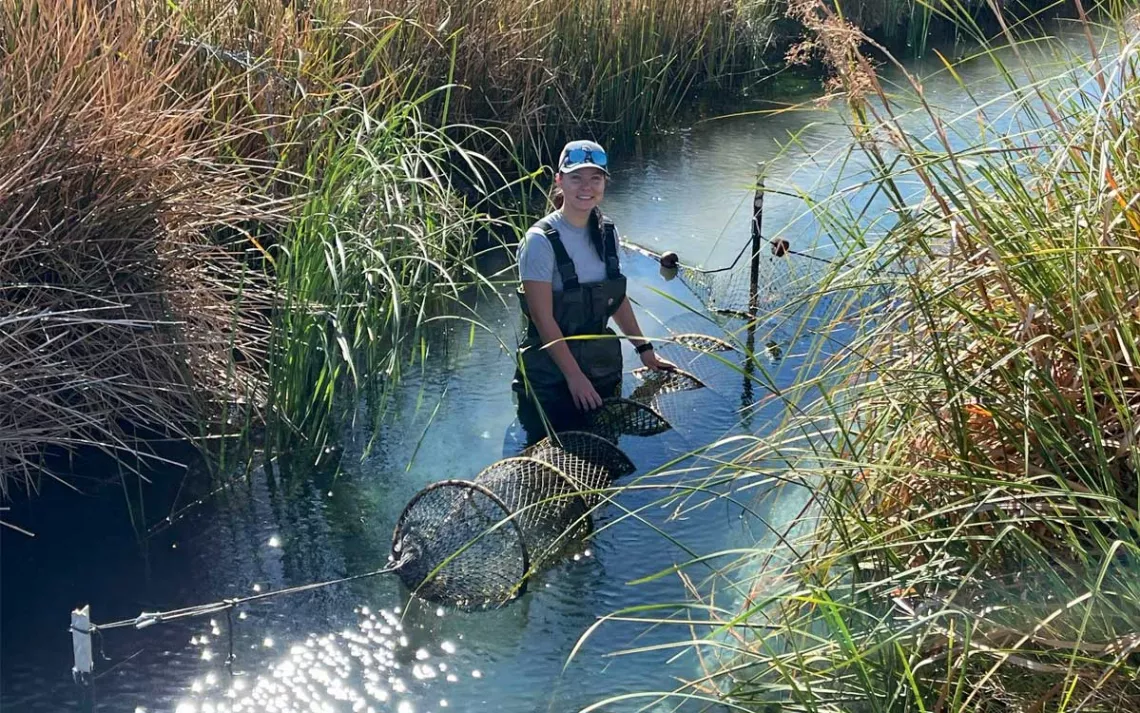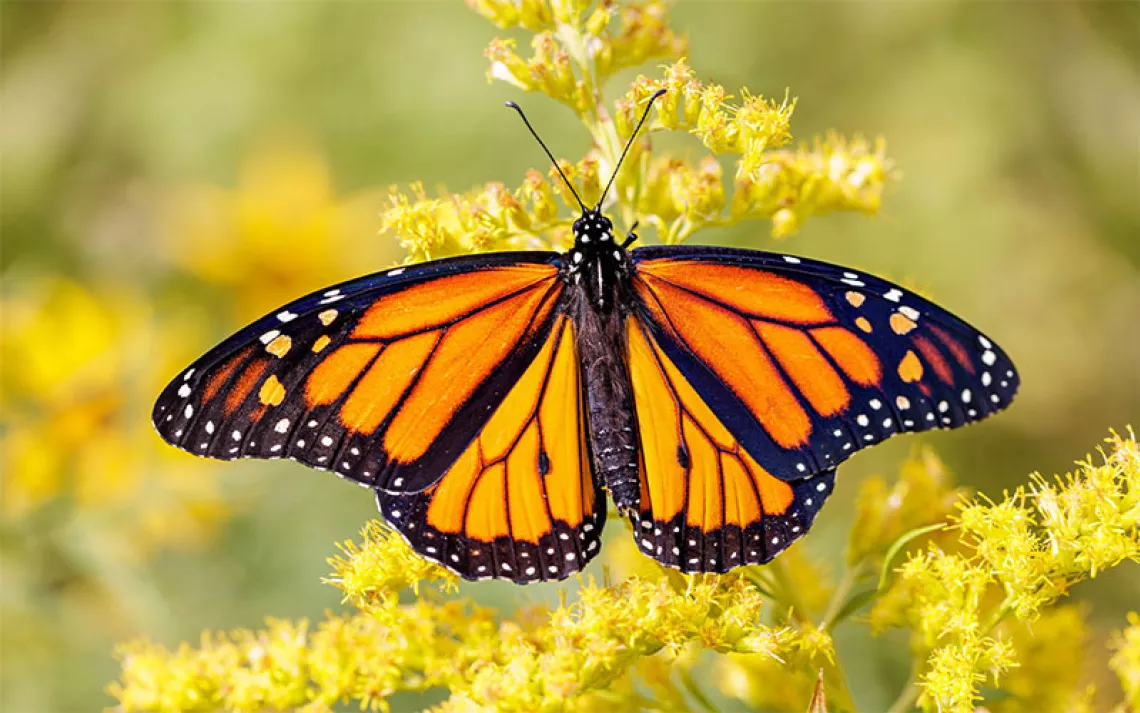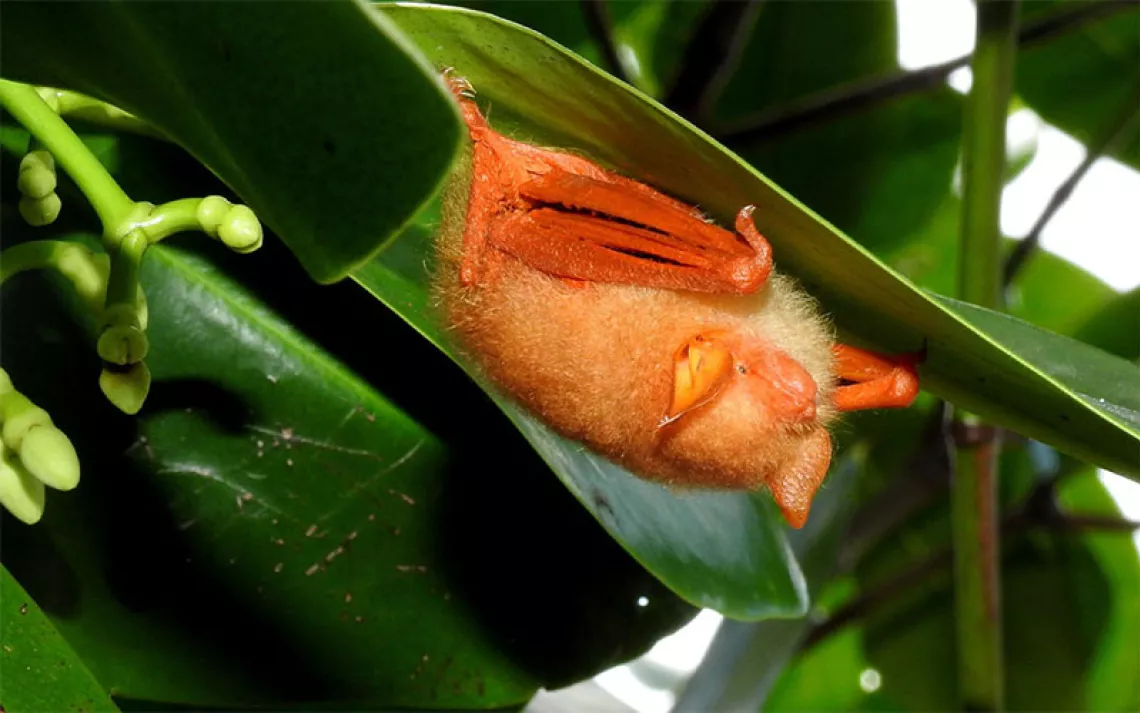The World's Second-Most-Famous Desert Pupfish Is in Trouble
You wouldn't believe the lengths people go to protect these fish

Pupfish protector Emma Priger uses a hoop net to capture invasive green sunfish. | Photo by USFWS
In the middle of the Mojave Desert, one of the hottest and driest places on Earth, is an unlikely blue aquatic jewel of an oasis. Its 24,000 acres have the highest concentration of endemic species in the country. Of those 26 species, a dozen are listed under the Endangered Species Act. And four of those protected desert species are fish.
But when I visited last spring, the most improbable thing of all was the dripping wet, bipedal vertebrate that emerged headfirst from the water wearing a mask and snorkel.
"What are you doing in there?" I called from the boardwalk. "Looking for invasive fish," she answered matter-of-factly. "And hoping to not find any."
The apparition was Emma Priger, an aquatic conservation intern at Nevada's Ash Meadows National Wildlife Refuge. She was winding up a year-long deployment with a focus on eradicating the green sunfish, an invasive predator. Since 2020, sunfish have been found in alarming numbers in the Crystal Springs system, where they prey on the endangered Ash Meadows Amargosa pupfish, a minnow-size fish that has lived in Crystal Springs and its outflows for millennia but whose existence is now imperiled by this much larger, hungry predator.
That three of the four endemic species in Ash Meadows managed to survive the past century was itself unlikely, according to Michael Bower, the refuge manager since 2021. During decades of peat mining and agricultural irrigation, virtually all the area's natural springs and seeps were capped, diverted, channelized, and "profoundly degraded," he said. "Everything that you now can see from the boardwalks along Crystal Springs used to be concrete irrigation ditches. I still can't explain how our pupfish species made it through the gauntlet of development."
Just a little over two miles from Crystal Springs lives the Ash Meadows Amargosa pupfish's more famous cousin, the Devils Hole pupfish, one of the first animals to be listed under the Endangered Species Act. It is possibly both the most endangered fish on Earth and the vertebrate with the smallest geographic range—the entire population lives in a single underwater cave. In 1976, the Supreme Court made the Devils Hole pupfish a controversial celebrity in these parts when its Cappaert v. United States decision ordered the federal government to limit pumping from the region's aquifer to protect the fish's tiny habitat. In Pahrump, the nearest sizable town, there were as many "Kill the Pupfish" bumper stickers as "Save the Pupfish" ones. Broader protection came in the early 1980s, when a proposed 20,000-unit resort development prompted the Nature Conservancy to purchase Ash Meadows and transfer it to the federal government. In 1984, Ash Meadows National Wildlife Refuge was established.
In the four decades since, the irrigation ditches, wells, and pumps have been removed and natural streambeds restored in much of the refuge. Devils Hole is completely cut off from the rest of the surface water system, so invasive fish aren't typically a problem there. But the Ash Meadows Amargosa pupfish live in pools and seeps that are connected to bodies of water where clueless, well-meaning folks dump unwanted aquarium fish.
Which is why Priger was at Crystal Springs hunting sunfish; they come from Crystal Reservoir, two miles downstream. For decades, it's been home to bass, green sunfish, crayfish, and other introduced fish that occasionally breach the barriers and make their way into the protected reaches of the system. This happened most recently during the pandemic, when refuge staff were stuck at home and unable to monitor and maintain the fish barriers and traps. By fall 2021, a dangerous number of green sunfish had made their way up into Crystal Springs.
With help from Nevada Department of Wildlife and National Park Service staff, Bower and his team took a multifront approach. Early on, they tried rod fishing, spearfishing, electrofishing, and hoop netting, carefully measuring the effectiveness of each. The winner was the hoop net, an anchored net funnel leading into an enclosure that green sunfish can swim into but not back out of. The catch peaked at almost 60 in September 2021. When Priger joined in 2022, she checked and emptied the traps at the refuge several times a week. Constant trapping and repairing of the fish barriers worked. In January 2023, the monthly catch was down to two. When I spotted Priger doing her snorkel survey in late April, she hadn't caught or even seen a green sunfish for two months.
Bower recently won a $12 million federal grant to reclaim Crystal Reservoir and restore the natural outflow of water from Crystal Springs. That will help revive the historic marshlands, a habitat that's too warm and shallow for green sunfish and other invasives to reproduce in. Also in the works here is a backcountry trail, codesigned by representatives of the Timbisha Shoshone and Southern Paiute Tribes, who consider this desert oasis sacred. They, along with the pupfish, have always considered it home.
 The Magazine of The Sierra Club
The Magazine of The Sierra Club



